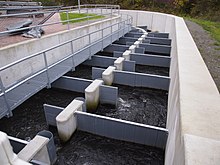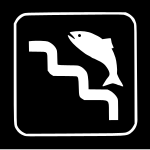Fish ladder
A fish ladder or fishway (also fishway , fish ladder , fish lifts , in Germany officially also Fischweg called) is a hydraulic engineering device to flowing waters to fish within the fish migration to overcome migration barriers in the form of weirs , hydroelectric power plants and optionally also falls to enable.
All river organisms and also small animals of the river bed ( macrozoobenthos ) are dependent on such fish ladders for migration. Therefore, in Germany, the fish ladders should not only serve the upward passage of fish, but also the migration of round mouths ( lamprey ) and the so-called macrozoobenthos .
Across Europe, the necessity of their establishment is justified, among other things, by the EU Water Framework Directive . The water management law, which has been adapted to this, regulates the arrangement of such systems when new dams are built or also in existing structures.
Hiking aids
A distinction must be made between walking aids for fish ascent ( fish ascent aids and systems ) and for fish descent (one type is referred to as bypasses ).
Fish ladder
Types
A distinction is made between natural and technical construction methods for the types of fish passages. The near-natural fish pass includes, above all, so-called rough ramps or rough glides , also bottom glides and bypass channels. The technical construction methods include, for example, slot passes, basin passes, eel ladder, fish locks , fish lifts or, more recently, fish ascent screws.
The currently authoritative data sheet DWA-M 509 differentiates between basin-like and channel-like fish ladders. It also contains specifications for structures that are passable by fish.
In the case of basin-like fish passes , the difference in height between the upper and lower water is reduced by building water basins with partition walls in between, with a small water level difference (currently according to DWA-M 509 between 9 and 15 cm) between these basins at the design flow a jet forms in the respective opening in the partition (loophole or slot), the kinetic energy of which is converted in the subsequent basin through the production of turbulence. With these types of fish pass, the total height difference is divided into many small sections. As a result, the maximum flow velocities that occur are kept within limits. In channel-like fish passages, the hydraulic power is converted by distributed roughness. This can be surface-covering roughness, individual disruptive bodies or, in the case of the bristle passes, also bristle modules.
A newer technique is the combination of a fish pass and a boat lane , the fish canoe pass .
Fish lift
With a fish lift , a large difference in height can be overcome in a small area. The functionality is largely independent of fluctuations in the water level in the headwater of the migration obstacle, provided that a connection between the fish lift and the headwater that is favorable for the fish can be established. As with other fish ladders, an artificially generated guide current guides the fish to the desired location.
The fish swim in a pool of water, the so-called trap basket, which has a device that prevents them from escaping. The water basin is now regularly moved upwards and gently tipped out at the top. Then the construction moves back down and opens the inlet for the next fish. For example, there is a fish lift at the Wyhlen hydroelectric power station at the Augst / Wyhlen barrage , at the Fuhren am Gadmerwasser socket , and another in Grellingen . In the two hydropower screws in Neubruck (near Scheibbs ) and Retznei that went into operation in 2015 , the fish lift is an integral part of the system.
Fish ascent screw

An Archimedean screw is used to raise water in which fish and other living beings can be carried into the upper water. One example is a small hydropower plant on the Url , in Amstetten in Lower Austria. In parallel to the hydropower screw that is used to generate electricity, another screw was installed for the ascent. Initial tests show a five times higher rate of ascent than other systems. However, the suitability of the fish ascent snail for weak-swimming small fish, lampreys and macrozoobenthos has not yet been proven.
Helix tower fish pass
The Helix tower fish pass is a fish path in the form of a spiral staircase tower with a meander basin . The cost of the fish passage at the Raisdorf hydropower plant was around 550,000 euros and was largely financed from EU funds. The first implementation in Raisdorf was described by the Association of Taxpayers and the State Nature Conservation Association of Schleswig-Holstein as a waste of taxpayers' money.
Lock or pilot current
If the fish are not guided directly into the fish pass through the geometric or hydraulic structure of the swimming area, which is only possible in special cases, they must be attracted by means of a guide current. This takes place through the flow of the fish passage itself, which emerges as a jet, or by means of an increased flow through an additional attractant flow. The optimal design of this guiding flow is currently still the subject of experiments and nature observations. Since this lure current corresponds to a not insignificant flow, turbines are sometimes integrated into the lure current line for energetic use (examples: fish pass Koblenz / Mosel or fish pass Iffezheim / Rhine)
The Lure Current Pump is a system developed at the University of Kassel to generate this guide current mainly from the underwater.
Examples
Electricity producer Vattenfall financed one of the largest plants in Europe at the Geesthacht barrage as an ecological compensation for the Moorburg coal-fired power plant further downstream . The serpentine-like connected 45 water basins allow migratory fish to swim around a weir between the estuary and the middle Elbe, which was built on the waterway to contain the tidal range. The Lahn window in casting enables using windows to look at a fish ladder in the Lahn at casting .
The highest fish ladders in Europe are on the Drau in Austria.
Since 2015, two hydropower screws with an integrated fish lift in Retznei an der Sulm and in Neuburg an der Jesnitz have been in operation in Austria, which are particularly well tolerated by fish. Studies by the University of Natural Resources and Life Sciences, Vienna, in which no injured fish could be found, show that most fish species were able to pass the facilities easily.
literature
- 1987: Günter Jens: The construction of fishing routes. Fish ladders, eel ladders and fish locks. Parey, Hamburg / Berlin 1982, ISBN 3-490-07414-9 .
- 1997: Beate Adam, Ulrich Schwevers: Function check of fish ways. Use of automatic control stations using transponder technology. Wirtschafts- und Verlagesellscft Gas und Wasser, Bonn 1997. ISBN 3-89554-069-2 .
- 1999: Jürgen Eberstaller: Fish passages - design criteria and functionality / Nature-like fish bypasses - design criteria and effectiveness. Dissertation University of Natural Resources and Life Sciences, Vienna : Institute for Water Provision, Water Quality and Fisheries Management. 1999.
- 2000: Michael Hütte: Ecology and Hydraulic Engineering. Ecological principles of water management and the use of hydropower. Parey, Vieweg 2000, ISBN 3-528-02583-2 .
- 2001: Beate Adam, Ulrich Schwevers: Planning aids for the construction of functional fish passages (= Library Nature & Science , Volume 17). VNW Verlag Natur und Wissenschaft, Solingen 2001, ISBN 3-927889-97-0 .
- 2004: Heinz Patt, Peter Jürging, Werner Kraus: Natural hydraulic engineering. Development and design of rivers. 2nd edition, Springer, Berlin 2004, ISBN 3-540-20095-9 .
- 2016: Matthias Meyer, Steffen Schweizer, Elena Andrey, Andres Fankhauser, Sandro Schläppi, Willy Müller, Martin Flück: The fish lift on Gadmerwasser in the Bernese Oberland, Switzerland . Springer, Wasserwirtschaft (2/3): pp. 42–48, ISSN 0043-0978
Web links
- Detailed description of the fish ladders (fish ladders) in Steinfurt / Burgsteinfurt
- Fish passages (approx. 5.3 MB) (from the Transverse Structures Handbook , 2005) (accessed on October 12, 2008; PDF file)
- The first fish lift in the canton of Bern - description of the fish pass at the Fuhren am Gadmerwasser socket
- Description of the large fish passes on the Rhine
- Gambsheim fish pass visitor center
- Fish ladder of the Seeve at the Holmer Mühle. Retrieved March 29, 2017 .
Individual evidence
- ^ Matthias Meyer. The first fish lift in the canton of Bern [1] . Description of the fish lift on the Fuhren socket. Retrieved April 8, 2016
- ↑ Markus Hintermann. When fish get into the elevator ... First fish elevator in Switzerland Archive link ( Memento from March 4, 2016 in the Internet Archive ). Detailed description of the Grellinger fish lift. Retrieved December 4, 2014
- ↑ Innovative "elevator" for fish on ORF from April 18, 2015, accessed on April 18, 2015
- ↑ Fish elevator: Monitoring brings excellent results on Oekonews.at from February 10, 2015, accessed on April 18, 2015.
- ^ Helix tower fish pass / Raisdorf hydropower plant. Retrieved February 12, 2019 .
- ↑ http://www.ruhr-uni-bochum.de/denkposter/68.pdf
- ^ Report in the Black Book 2005 of the Federation of Taxpayers ( Memento from September 24, 2015 in the Internet Archive ) (pdf, approx. 1.77 MB, pages 46–47)
- ↑ Schilda sends his regards. Handelsblatt.de , article from September 27, 2005, 4:55 p.m.
- ↑ Migratory fish: Emergency aid for migrants on zeit.de
- ↑ Europe's largest fish ladder near Geesthacht: Protection for the Elbe and fish on vattenfall.de ( Memento from July 23, 2012 in the Internet Archive )
- ↑ Carinthia's highest fish ladder in operation. In: Umweltjournal-online.at. September 12, 2019, accessed December 23, 2019 .
- ↑ The highest fish ladder in Europe is being built. In: energie-bau.at. December 9, 2019, accessed December 23, 2019 .
- ↑ patent no. 512766, filing date: January 13, 2012, publication date: February 15, 2015, applicant and inventor: Walter Albrecht.
- ↑ B. Zeiringer: Fish Passage through a Hydro Dynamic Double-Screw: An Alternative Solution for Restoring River Connectivity . American Fisheries Society, 145th Annual Meeting in Portland, OR, August 16-20, 2015: Abstract on the American Fisheries Society website . The plant on the Sulm is operated by Verbund. The development company Hydroconnect operates the plant on the Jesnitz itself.
- ↑ abstract







